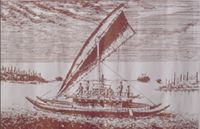
The island's history

Isle of Pines’ history goes back well before the time of Christ and contains numerous enigmas.
There are more than a hundred puzzling mounds, tumuli, on the iron plateau near the airport. Were they nests of giant, wingless birds that lived on the island more than ten-thousand years ago ? Or did humans build them ?
Fragments of pottery, recognised as belonging to Lapita - a navigating race of austronesian descent, have been found in the coastline at Vao and have been dated by archaeologists at around 1500 years B.C. ...
did the Lapita people live on the island, or were they simply passing by ?
How
long have the present indigenous people inhabited this beautiful island
? According to ancestral wisdom, warriors of Tongan descent came from
Lifou (one of the New Caledonian Loyalty islands) and settled on Isle
of Pines about three centuries ago - they were invited by the existing
inhabitants to take over leadership of the island and the role of High
Chief.



Later on,
in the 18th century, the first European explorers left accounts of their
voyages, notably the English Captain James Cook, who charted the coastal
waters and left for posterity the official name, the Isle of Pines, after
the tall, columnar, native pines (araucaria columnaris). Cook never set
foot on the island, but noted it was inhabited because he saw smoke ...
who were these inhabitants ? And did they see the large, strange sailing
vessel ?
The 1840s saw the arrival of missionaries, Protestant then Catholic, and
traders looking for precious sandal-wood. Why did the Anglo-Saxon merchants
set up depots without colonising the island ? Why did the Kunies opt for
the Catholic religion and subsequently for French possession in 1853?
Not long afterwards, in 1872, why did the Kunie people find themselves
before a fait accompli that transformed their island into a convict settlement
for 3000 political deportees from the Paris Commune ?
Today, nearly 130 years later, the island is less populated than previously and remains extremely protected by the tribal system. After such a turbulent history, it’s understandable the Kunies guard their land closely. Isle of Pines has become an indigenous reserve and the land is neither for sale nor for rent.
©
idp
01/10